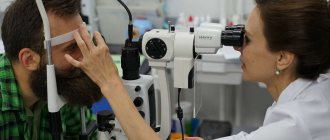The influence of ocular manifestations of diabetes mellitus on human vision.
Diabetic retinopathy is damage to the retina that occurs with diabetes.
A high level of long-term glycemia changes the structure of the wall of the retinal blood vessels, making them more permeable, allowing fluid to penetrate into the intraretinal space. The development of diabetic retinopathy most often occurs in people 5-10 years after the onset of diabetes. Diabetic retinopathy occurs differently depending on the type of diabetes. In type I (insulin-dependent), it is rapid - in this case, proliferative diabetic retinopathy (an advanced stage of the disease) occurs quite quickly. In type II diabetes mellitus (non-insulin-dependent), changes arise and develop in the central zone of the retina. Diabetic retinopathy is a disease that mainly causes blindness in people whose ages range from 20 to 65 years. Diabetes mellitus, high blood pressure, excess weight, high cholesterol levels are all factors that increase the risk of complications significantly.
Classification
According to the clinical picture, diabetic retinopathy is divided into three main forms: background nonproliferative, preproliferative and proliferative. As can be seen from the terms, the distinguishing criterion in this classification is proliferation (“growth”). In this case, we mean the tendency to form and branch a network of new blood vessels (this phenomenon is more accurately called neovascularization), which is observed in the later stages of retinopathy, when the own vessels are no longer able to provide blood supply to the retina.
In addition, diabetic maculopathy, or diabetic macular edema (predominantly affecting the central photosensitive macular zone of the retina) is considered as a relatively independent form.
Background (non-proliferative) retinopathy is the initial stage of diabetic retinopathy. Subjectively, it may not be felt, visual functions are not significantly affected, or the symptoms are “flickering” (impairments appear and then disappear again for a while). Clinically it is characterized mainly by angiopathic (vascular) focal changes: the formation of lipid plaques, thickening of the basement membrane, increased permeability of the walls. Microaneurysms (protrusions) and microhemorrhages are possible - minor hemorrhages and bruises under the vessels.
Preproliferative retinopathy is a natural development of the initial phase. At the second stage, retinal ischemia acquires a distinct character, multiple pathological foci are formed, hemorrhages become more frequent and intensified, the structure and appearance of the veins change.
Finally, proliferative retinopathy is characterized by active neovascularization, proliferation of fibrous tissue, gross organic changes in the tissue of the vascular walls and functional degradation of blood vessels; hemorrhages become massive and reach the level of general hemophthalmos (intraocular hemorrhage). The ingrowth of newly formed vessels leads to various kinds of mechanical anomalies - traction (stretching), compression, compression, etc., which can lead to catastrophic consequences for the eye: for example, the diagnosis of “tractional retinal detachment” literally means forceful separation of the retina by ingrown into the vitreous and mechanically stressed ties.
Diabetic macular edema , i.e. edema of the central zone of the retina (macula, macula) is divided according to the degree of prevalence into focal (local) and diffuse, covering the entire area of the macula. It can lead to loss of central vision, since the photosensitive macula, or macula, is responsible for this visual field, which is the sharpest and clearest. Swelling develops as a result of abundant effusion from blood vessels, liquid and solid exudative foci are formed.
Causes
Long-term hyperglycemia (increased blood sugar) is the main and most significant cause of the development of diabetic retinopathy. This disease is diagnosed in approximately half of people who have diabetes mellitus for approximately 10-15 years.
Factors in the development of pathology include:
- Long-term smoking;
- Overweight;
- Genetic predisposition;
- Chronic renal failure;
- History of frequent episodes of hypoglycemia.
Causes
Significant damage to the retina, diagnosed by specialists as retinopathy, can occur for several reasons:
- presence of chronic diseases;
- severe illness or significant fatigue;
- injury.
The reasons for the development of primary forms have not been established. The causes of the development of secondary retinopathy are complications arising from the following health problems:
- hypertension;
- systemic atherosclerosis;
- pathologies of the circulatory system;
- renal failure;
- injuries to the chest or eyeball;
- diabetes mellitus;
- toxicosis.
Experts believe that the cause of the development of retinopathy in newborns is underdevelopment of the retina in children who were born prematurely. Ophthalmologists associate this problem with the process of nursing babies in special boxes.
Symptoms of diabetic retinopathy
Symptoms of the disease appear in the later stages of development, usually when the process becomes irreversible. Most often, the disease is asymptomatic, but patients may complain of a blurry image of objects. For many people, symptoms may not appear until the disease progresses to more severe stages, at which point it can lead to vision loss and blindness. For this reason, all patients diagnosed with diabetes should undergo an ophthalmological examination every six months.
The main symptoms of diabetic retinopathy:
- Decreased vision (more often this symptom indicates severe stages of retinopathy);
- Twinkling “stars” in the eyes;
- Discomfort and pain in the eyes;
- Decreased visual acuity and the presence of a “veil” before the eyes;
- It is possible to develop complete blindness.
If you experience similar symptoms of the development of this disease, we advise you to make an appointment with an ophthalmologist at the Federal Scientific and Clinical Center of the Federal Medical and Biological Agency. Timely diagnosis will prevent possible negative consequences for your health!
What is diabetes mellitus?
Diabetes mellitus is a disease of the endocrine system, in which the permissible level of sugar (glucose) in the blood increases. This condition is called hyperglycemia.
In this article
- What is diabetes mellitus?
- What is diabetic retinopathy?
- What happens to vision with diabetic retinopathy?
- Stages of diabetic retinopathy
- Signs of diabetic retinopathy
- What factors can trigger retinopathy in diabetes?
- Diagnosis of diabetic retinopathy
- Treatment of diabetic retinopathy
This happens because the body does not produce enough insulin in diabetes. Insulin is a hormone synthesized by beta cells of the pancreas. They respond to increased glucose levels and send a certain amount of insulin to lower the level in the blood. In diabetes, metabolism of all types is disrupted: carbohydrate, water-salt, protein and others. In recent years, there has been a steady increase in the number of people with diabetes. In Russia, as of 2021, more than 3.7 million patients with this diagnosis are registered. However, according to the International Diabetes Federation, the real number of patients reaches 12 million people. Half of the patients are not even aware of their disease. But if it is not treated in time, it leads to serious health consequences. One of them is diabetic retinopathy.
Diagnostics
To determine the disease, it is first necessary to consult an ophthalmologist. To diagnose your vision, your doctor will conduct some tests:
- Perimetry (ophthalmological examination in which the field of vision is determined);
- Biomicroscopy (detailed study of the structures of the visual organs using a slit lamp);
- Ophthalmoscopy (a method of examining the fundus of the eye using a special optical device);
- Fundus photography (a diagnostic study during which photographs of the fundus structures are taken using a special camera);
- Optical coherence tomography of the retina (examination of tissue with a laser device).
The results of the listed diagnostic studies will give the doctor a complete picture of the patient’s vision condition. Treatment will be prescribed based on information about the stage of development of the pathological process in the eyes. At the Federal Scientific and Clinical Center of the Federal Medical and Biological Agency, you can undergo all the specified diagnostic tests and receive a consultation with a treatment regimen during one visit to our center.
Varieties
The category of primary retinopathies, the causes of which are unknown, includes the following types of disease:
- central serous, diagnosed in adult men with a history of headaches after emotional stress;
- external exudative is diagnosed most often in young men;
- multifocal pigmentary, which is characterized by previously impaired central vision.
The category of secondary retinopathy, the causes of which are very different, includes the following types of disease:
- hypertensive, the cause of which is considered to be kidney disease, arterial hypertension, manifestations of toxicosis in pregnant women. Ophthalmologists indicate 4 stages of the disease;
- atherosclerotic, the cause of which is systemic atherosclerosis;
- diabetic, develops in the presence of diabetes mellitus of one of 2 types. This type leads to low vision and blindness if the patient does not consult a doctor in time. The main causes of development: chronic diabetes, obesity, neuropathy, anemia, etc. Experts distinguish 3 forms of the disease;
- retinopathy, the cause of which is blood diseases of various pathologies: leukemia, polycythemia, anemia, myeloma, etc. Each form is characterized by a specific ophthalmoscopic picture;
- traumatic, occurring due to compression of the chest sharply and quickly, followed by ocular hemorrhages. Without treatment, optic nerve atrophy is possible.
Treatment of diabetic retinopathy
The level of glucose and glycated hemoglobin in the blood is one of the most important indicators in treatment. The therapy is based on strict regular monitoring of these indicators. It is necessary to carefully organize the treatment of the patient’s underlying disease – diabetes.
During the treatment of diabetic retinopathy, a multidisciplinary approach is required; not only ophthalmologists, but also endocrinologists should be involved in treatment. The choice of treatment method largely depends on the current stage of the disease.
The following methods of treating diabetic retinopathy are used at the Federal Scientific and Clinical Center of FMBA:
- Drug therapy. Angioprotective drugs, steroidal and non-steroidal anti-inflammatory drugs, anticoagulants, and drugs to improve microcirculation are used (according to indications).
- Laser treatment. At this point in time, the most effective and reliable method of preventing the development of diabetic retinopathy is laser coagulation of the retina (RLC). LCS is an outpatient procedure. It is absolutely painless for patients; local anesthesia is used during the procedure, which eliminates pain. The purpose of LCS is coagulation (“cauterization”) of ischemic areas of the retina, as well as the most incompetent “leaking” retinal vessels and, possibly, the creation of temporary pathways for the outflow of accumulated intraretinal fluid.
- Endovitreal administration of neoangiogenesis inhibitors (Lucentis or Eylea) as well as the drug Ozurdex. This type of treatment is used for the development of macular edema. These drugs are injected into the vitreous body in an operating room under local drip anesthesia. After administering the drug, the patient goes home 1-2 hours later with the necessary recommendations. The therapeutic effect of the implant lasts from 30 to 90 days from the date of insertion.
- Microinvasive vitrectomy. Removal of the vitreous humor (the transparent gel that fills the eye cavity) - in the presence of hemorrhages in the vitreal cavity.
- Surgical treatment of tractional retinal detachments occurring in proliferative diabetic retinopathy. Modern methods of vitreoretinal surgery are used with the introduction of special substances into the eye cavity - silicone oil or gas-air mixtures.
Diabetic retinopathy is a complication of diabetes mellitus types 1 and 2 with its long-term decompensation. It manifests itself as progressive damage to the vessels of the fundus. Retinopathy is accompanied by their gradual destruction, microscopic aneurysms, hemorrhages into surrounding tissues, and atypical proliferation of capillaries. In the absence of timely examination and adequate treatment, it leads to a sharp deterioration in visual acuity. In severe cases it can result in blindness.
Causes of diabetic retinopathy
The main factors in the development of this complication are the specific course of diabetes mellitus. The risk of eye vascular damage in diabetics increases rapidly:
- due to prolonged hyperglycemia, when the level of glycated hemoglobin exceeds 8-9%;
- in the presence of hypertension, nephropathy, atherosclerotic changes;
- during pregnancy, genetic inheritance of predisposition;
- with age or due to bad habits - smoking, drinking alcohol.
The main causes of angiopathy in diabetics, that is, extensive damage to small and large vessels of target organs (eyes, heart, kidneys, lower extremities), remain high blood sugar and high blood pressure. By erasing them from your life, you can delay the onset of complications by decades. Or don't encounter them at all.
Classification, stages of diabetic retinopathy
Tissue proliferation is their growth. Therefore, according to the generally accepted classification, the course of retinopathy in diabetics is divided into three stages.
- Non-proliferative. Characteristic features of the initial stage are pathological changes in the structure of the retina of the eyes - small aneurysms, foci of exudate, hemorrhages. At this stage, tissue swelling is diagnosed.
- Preproliferative. Accompanied by obvious venous and capillary anomalies - the appearance of nodules, arteriole loops, and vascular tortuosity. Large hemorrhages on the surface of the retina are possible.
- Proliferative. It is characterized by an abnormal proliferation of small vessels of the optic nerve head and other parts of the retina. Since newly formed capillaries are fragile and have thin walls, their appearance increases the risk of hemorrhage. Repeated hemorrhages contribute to the formation of fibrous tissue and scars. This can lead to glaucoma, atrophy and retinal detachment.
End stage is the last stage of retinopathy, which is diagnosed in 2% of patients. In this case, the changes are almost irreversible, leading to complete loss of vision.
Important! Stages 1 and 2 develop unnoticed by the patient. Only at the third, proliferative stage, visible signs appear: decreased clarity and distortion of objects, deteriorating night vision. Therefore, for diabetics, periodic examinations by an ophthalmologist is rule No. 1, and in no case should you deviate from it.
Clinical picture and symptoms
Symptoms usually follow each other in a certain sequence. An experienced ophthalmologist will notice their development, since the progression of the disease is accompanied step by step by:
- vasodilation of blood vessels - relaxation of their smooth muscles, temporary expansion;
- increased blood flow in arterioles, capillaries, veins;
- damage to the vascular endothelium, blockage of capillaries, increased permeability of the walls;
- the formation of microscopic aneurysms - protrusion of the walls of blood vessels with their thinning in these places;
- the appearance of branches of fragile capillaries, their growth.
This leads to an avalanche-like occurrence of hemorrhages, oxygen starvation, swelling and gradual degeneration of the retina.
Diagnosis of retinopathy in type 1 and type 2 diabetes
Diagnostic measures begin with interviewing the patient and measuring visual acuity using tables. Diabetics with more than 10 years of experience must have their intraocular pressure checked. After this, an ophthalmoscopy is performed - an examination of the fundus, which is the most important method for diagnosing eye diseases. It usually includes:
- biomicroscopy of the vitreous body, retina, lens and other structures of the eye using a slit lamp;
- instrumental examination of the optic nerve, macula (macular zone);
- stereoscopic photography of the retina with a special retinal camera;
- Ultrasound examination of the retina is necessary for clouding of the lens, cornea, or vitreous body of the eye.
According to indications, X-ray angiography with intravenous administration of a contrast agent - an organic solution of fluorescein - may be prescribed.
Treatment methods for diabetic retinopathy
In this case, complex therapy is required, observation and prescription are carried out by attending physicians - an endocrinologist and an ophthalmologist. It is advisable to strictly adhere to the prescribed insulin therapy regimen; a diet excluding animal fats and fast carbohydrates is also important.
Vitamin therapy is carried out 3-4 times a year for a month; special importance is given to the stable supply of B vitamins to the body. Angioprotectors are selected as prescribed by the doctor - agents that strengthen the walls of blood vessels. The first stage of the disease requires frequent repeated examinations by an ophthalmologist and strict control of blood sugar. When diagnosing the second and third stages, radical solutions are required - laser photocoagulation, injections of special angiogenesis blockers, or surgery - vitrectomy.
Laser photocoagulation: details
Photocoagulation is a targeted method for treating retinal pathologies that uses krypton, argon or diode pulsed light sources. This technique, used in laser surgery, makes it possible to “cauterize” the newly formed blood vessels of the eye, which stops their further growth and aggravation of symptoms.
Over time, the treated capillaries are overgrown with fibrous tissue, and blood circulation in the rest is restored. Even in the later stages of the disease, this method allows one to preserve vision in 50-60% of patients. Photocoagulation can be prescribed urgently if glycated hemoglobin levels exceed 10% and significant degenerative changes have already been detected. Because in this case the risk of vision loss is too high.
When is vitrectomy necessary?
Surgery is required when the third, proliferative stage of the disease is diagnosed, and all other methods are not appropriate. Also reasons are:
- The presence of fundus lesions due to diabetes with the formation of strands and scars.
- Detection of a fibrous film on the retina.
- Complete or partial detachment of the retina, its rupture in the macular zone.
- Extensive hemorrhages into the vitreous body.
Sometimes vitrectomy is the only chance to save vision. In modern clinics, such operations are performed minimally invasively, through microtunnels, and do not require general anesthesia. Standard vitrectomy consists of:
- cutting the retinal ligaments, removing the vitreous, which is replaced with a special solution;
- when the retina peels off, return it to its place;
- removal of blood clots that have arisen during hemorrhages.
According to statistics, after this, visual functions are restored in 80-90% of patients, and repeated surgery may be necessary after 10-12 years. But if the retina has been significantly atrophied or detached, the chances of success are reduced.
Prevention of vascular complications in diabetics
Preserving vision with diabetes is now more than possible. The basis of prevention is optimal compensation for the underlying disease, preventing too sudden changes in blood sugar or prolonged hyperglycemia. You also need to keep your blood pressure under control, since its increase can lead to dire consequences - not only to vascular damage to the eyes, but also to a stroke or myocardial infarction.
To prevent further progression of retinopathy, you need to undergo a timely examination by an experienced ophthalmologist. The frequency of diagnostic examinations depends on the extent of the disease. In its absence, you need to visit a doctor 1-2 times a year, but if vascular problems are already present, the frequency of annual examinations can reach 4-5 times or more.
Symptoms
The main symptom indicating the occurrence of retinopathy is blurred and decreased vision. The disease manifests itself as follows:
- visual acuity decreases;
- floating spots and veils, dark spots, dots appear before the eyes;
- field of view is reduced;
- the whites of the eyes turn red due to hemorrhage or proliferation of blood vessels in the eyes;
- the shade of the pupil changes or the reaction of the pupil worsens (painful sensations are possible);
- headaches appear, accompanied by dizziness and nausea;
- unexpected blindness may occur.
When the disease first begins, it becomes difficult to read and do minor work. With different types of retinopathy, symptoms manifest themselves differently, so only a qualified ophthalmologist can give an accurate diagnosis.







